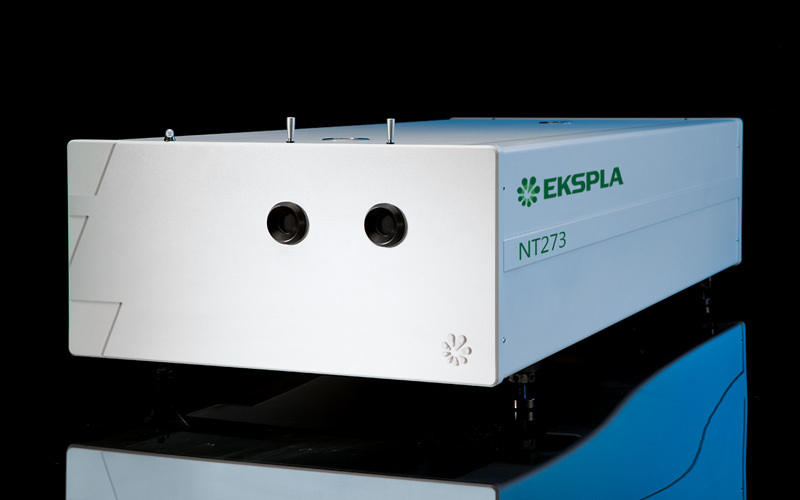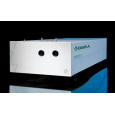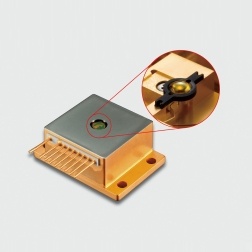方案详情
文
采用立陶宛Ekspla公司的可调谐激光光源NT200激光器,对波长改变时变换贝塞尔光束沿晶体轴线扩散的现象进行了实验观察。
方案详情

Computer Optics and Nanophotonics /V.S. Vasilev, V.V. Podlipnov Experimantal oberving of transformation Bessel beam spreading alongaxis of crystal during wavelength changes V.S. Vasiley,V.V. Podlipnov’ 'Samara National Research University, 34 Moskovskoe Shosse, 443086, Samara, Russia Image Processing Systems Institute -Branch ofthe Federal Scientific Research Centre “Crystallography and Photonics”ofRussian Academy ofSciences, 151Molodogvardeyskaya st., 443001, Samara, Russia Abstract In paper decribe experimental observing transform bessel beam, formed by diffraction axicon in moment propagation through anisortopicbCoVeirefringence crystal. This observation covers large range wavelength changes (from 520 nm to 534 nm). Theoretical explain effect is given. Keywords: laser with changing wavelength; diffraction axicon; birefringent crystal; bessel beams 1. Introduction It is well-known the usage of anisotrophic elements to convert beams with the homogeneous polarization into cylindricalvector beams [1-6]. At the same time, it is necessary to implement the separation of the longitudinal modes along the opticalaxis of the system, which is parallel to the axis of the crystal. To improve convergence of the beams in the crystal, it is possibleto use telescopic system or to form beams with high numerical aperture. Polarization and mode conversion during propagationalong the axis of the crystal were considered for both Bessel and Gaussian beams [7-16]. It has been shown in the studies [17, 18] that during the propagation along the crystal axis neuraxial Bessel beams have otherproperties than Gaussian beams, namely, experiencing a uniform periodic change of intensity. In this case, the Bessel beam ofzero order and second-order are periodically converted from one to another [7-9, 17, 18]. The oscillation period is directlyproportional to the wavelength of the laser radiation and inversely proportional to the square of the spatial frequency of the laserbeam and the difference of the dielectric capacitivity, which is corresponding to the ordinary and extraordinary rays. Thisdependence allows control occurring transformation in the crystal due to changes of the characteristics in either Bessel beam orcrystal. In particular, the spatial frequency of the beam depends on the numerical aperture of the axicon [19-22] which shapesthe beam, also it is possible to adjust characteristics of the beam by changing the beam divergence [23]. To change theparameters of the crystal, it can be heated [24] or effected by electro-optic [25]. However, the most convenient way ofadjustment is to change the wavelength of the laser radiation which has a direct linear relationship from the period oftransformation [26]. It was experimentally demonstrated the ability [26] to manage the transformation of the Bessel beam at the output of theCaCO3 crystal by changing the wavelength of the radiation illuminating the diffractive axicon. It was achieved almost completetransformation of the Bessel beam of zero order beam to the second order using the axicon period of2 um and the wavelength at^A=1.5 of the initial value of A=637.5. The variation of the wavelength within a small range was achieved by changing thetemperature of the laser. In contrast to this method, the usage of a laser with variable wavelength provides a wide range ofAA,and therefore the possibility of achieving complete conversion using the axicon with a large period, i.e., a smaller numericalaperture. Note that the usage of axicons with high numerical aperture is limited not only with technological possibilities ofproduction [27] and reduction of non-diffraction distribution cut [20], but with the limiting numerical aperture [28], in whichpropagating waves occur in the considered optical medium. This paper shows the results of experimental observation of the mode conversion of Bessel beam formed by the axiconamplitude with a period of 3 um with the output of a deuterated potassium dihydrogen phosphate crystal when the wavelengthof the laser EKSPLA NT 200 radiation is changed. 2. Theoretical analysis Consider an anisotrophic crystal whose axis is oriented along the optical axis. The intensity distribution I(x,y,z) in the propagation of Bessel beam along the axis of the crystal is as follows [9, 11, 17, 18]: where a- numerical aperture of the beam, z - is the distance traveled; yo, ye- are the values which are determining thedirection of propagation of the o rdinary and extraordinary rays: A complete transformation of the Bessel beam of zero order to the beam of second order will periodically occur at distancesthat are multiples of the value: Full transformation period depends on the refractive indices of the crystal and the numerical aperture of the axicon, as well ason the wave length of radiation. Moreover, the wavelength dependence is direct and linear, i.e. the most convenient todynamically change the value of period so that the output of the crystal is formed the desired pattern. 3. Experimental results 3.1. Method ofexperiment In this paper experiments were conducted using the optical arrangement shown in the fig.1, where 1 - laser with changingwavelength EKSPLA NT 200, 2 - diaphragm, 3- collimator, 4 - diaphragm, 5 -DOE, 6 -anisotropic crystal, 7 -20xmicroobjective,8- digital USB camera TOUPCAM UCMOS05100KPA. 3 Fig. 1. Optical setup of the experiment. A laser with variable wavelength was used as a radiation source EKSPLA NT 200. In the considered range of wavelengthvariation (520- 534 nm), the laser beam has a horizontal X-polarization. The energy of the laser radiation obtained in the rangeofthe visible spectrum wavelength is variable from 610 microjoule (450 nm) to 45 microjoule (700 nm). The extension of thebeam is done by the collimator. Owing to the fact that the beam emerging from the laser has a Gaussian intensity distribution, ithas become necessary to select a part of the beam with a small change of intensity. This problem can be solved by introductionof a diaphragm 2. Septum 4 allows to limit the numerical aperture and to enable formation of the propagating waves. Theintensity distribution of the output beam was recorded with a digital USB camera with a resolution of 5 mega pixels and ADCdigit capacity of 12 bits. The Bessel beam of zero order is formed by using a diffraction amplitude of the axicon with period which operates withnearly the same effectiveness in the considered wavelength range. The Bessel beam was directed along the axis of a crystal withcross-sectional dimension and length 20 mm. As a result of Bessel beams transformation there were formed interference patternintensity distribution for different wavelengths and it was recorded with the microscope objective and digital cameras (table 1).To highlight different X and Y components of the transformed beams a rotating analyzer was installed in front of the digitalcamera. 3.2. Results and discussion As you can see in the images, when the wavelength changes by AA=14 nm there is a complete transformation of the Besselbeam of the first order to the second, which is caused by the reaction of doubly refracting crystal. The observed phenomenon isexplained by the formula (4), where A is in the numerator. At the same time, change of wavelength is similar to the changes ofthe propagation length of the beam, as if it had been changed the dimensions of the crystal. To verify the observed phenomenonin the described conversion model it was carried out an additional numerical calculation for the wavelength of 520 nm and 532nm. Intensity distributions of the Bessel beams images which were converted by electro-optic crystal for given experimentalconditions obtained by numerical calculation are presented in table 2. Based on the simulation results, we can conclude that the observed experimental results are very similarity with themathematical description for the Bessel beams conversion in the considered wavelength range. Table 1.Distribution of intensity bessel beams tranformed in birefringent crystal. Wavelength 520 522 524 526 X component Y component Wavelength 528 530 532 534 X component Y component Table2. Modeling distribution of intensity bessel beams transformed in birefringent crystal. 4. Conclusion It was experimentally demonstrated the conversion of Bessel beams of zero order, generated by the axicon with period inbirefringence crystal, depending on the change of the wavelength of the laser radiation in the range of l=520-534 nm to theBessel beams of the second order, which has an annular intensity distribution. Further increase of the wavelength has showed arecurrent re-transformation into a Bessel beam of zero order. Comparative analysis of experimental images of full intensity andtheir components with images obtained by the numerical simulation has showed their similarity. Asknowledgement This work was supported by the Ministry of Education, by the Russian Foundation for Basic Research (grant 16-29-11698ofi_m and 16-07-00494 a) and by the grant from the President of the Russian Federation to support young Russianscientists-doctors of science, (project no. MD-5205.2016.9). References ( [1] M achavariani G , Lumer Y, Mos h e I, Meir A, Jackel S, Davi d son N. Birefringence-induced bifocusing for selection of radially or az i muthally polarized l aser modes. Applied Optics 2007;46(16): 3304. ) Yonezawa K, Kozawa Y, Sato S. Compact laser with radial polarization using birefringent laser medium. Journal of Applied Physics 2007;1(1): 5160. ( Zhan Q . C y lindrical v e ctor beams: from mathematical concepts to applications. Advances in Op t ics and Photonics 2009; 1(1): 57. ) ( F adeyeva T, Shvedov V, Sh o stka N,Alexeyev C, Voly a r A. Natural shaping of the cylindrically pol a rized beams. Optics Letters 2010;235(22): 3787. ) ( K honina S N , Karpeev SV , Alferov SV. Theo r etical and an e xp e rimental res e arch of p ol a rizing tr a nsformations in u n iaxial crystals f or generationcylindrical vector beams of high order s . Computer Optic s 2014;38(2):171 -1 80. ) ( [6] K honina SN, Karpeev SV, Alfe r ov SV, Soif e r VA. Generation of cylindrical vector b eams of high orders using uniaxial crystals. Journal o f Optics 2015; 1 7(1): 11. ) ( K hilo NA, Ryzhevich AA , Petrova ES. Tra n sformation of the order of Bessel beams in uniaxial crystals. Q u antum Electronics 2001;31(1):85-8 9 . ) ( K hilo NA. D i ffraction and order conversion of Bessel beams i n uniaxial crystals. Optics Communications2012;285(1):503-509. ) ( K honina S N , Morozov AA, Karp e ev SV. E f fective transformation of a zero-order Bessel beam i nto a second-order vortex beam using a uniaxia l crystal. L aser P hys. 2014: 24(1):5. ) ( [10] K honina SN, Pa r anin VD , Ustinov AV, Kras n ov AP. A s tigmatic transformation of Bessel beams in a unia x i a l crystal. Optica Applicata 2016; Vol. 4 6(1) : 5-18. ) ( [11] K honina SN, Karpeev S V , Morozov AA, Paranin VD. Impl e mentation of o r dinary and extraordinary beams interference by application of diffractiveoptical elements. Journa l of Modern Optics 2016;63(13): 1 239-1 2 47. ) ( [12] Ciattoni A, Cincotti G, Palma C. C ircularly polarized beams a nd vortex generation i n uniaxial media. J. Opt. Soc . Am. A 2003;20(1):163-17 1 . ) ( [131 M arrucci L, M anzo C, P a paro D. Optical s p in-to-orbital angular momentum c o nversion i n inhomogeneous anisotropic m e dia. P h ys. Rev. L e tt. 2 006; 96(1):130-135. ) ( [14] L oussert C, Brasselet E. E f ficient scalar and vectorial s ingular beam s h aping using homogeneous anisotropic media Optics Letters 2010; 35(1): 7-9. ) ( [15] F adeyeva TA, Shvedov VG, Iz d ebskaya YV , Volyar AV, Brasselet E, Ne s hev DN, Desyatnikov AS, Krolikowski W, Kivs h ar YS. Spatially eng i neered p olarization states and optical vortices in uniaxial crystals. Optics Exp r ess 2010; 18(10): 63. ) ( [16] P icon A , B enseny A, Mompart J, Calvo GF. Spin and orbital angular momentum propagation in a n isotropic media: t heory. J. Opt. 2011; 1 3(1):7. ) ( [17] ] K honina SN, Volotovsky SG, Kha r itonov SI. F eatures of nonparaxial propagation of G a ussian and Bessel beams along t he ax i s of the crystal. ComputerOptics 2013;37(3):297-306. ) ( [18 ] ] Khonina S N , Kharitonov SI. Comparative inve s tigation of nonparaxial mode propagation along t he axis of uniaxial crysta l . Journ a l of Moder n Optics 2015;62(2):125- 1 34. ) ( [19] M cLeod, JH. The axicon: a new type of optical element. Journal of the Optical Society of America 1954; 44: 592-597. ) ( [201 T urunen J, Vasara A, Friberg AT. Holographic generation of diffraction-free beams. J. Appl. Opt. 1988 ; 27(19):3959-3962. ) ( [21] Khonina SN, K o tlyar VV. Bessel-mode formers. Proceedings of SPIE 1994; 23(63):184-190. ) ( 221Chattrapiban N, Rogers E, Cofield D, Hi l l W, Ro y R. Generation of nondiffracting Bessel beams by use of a spatial light m odulator. Opt. Lett. 2003; 28(22):2183-2185. ) ( [23] Paranin VD, Karpeev SV , Khonina SN. Control of the formation of vortex Bessel be a ms in u niaxial crystals by varying the beam divergence. Q u antum Flectroniss 2016;4602163-168, ) ( [24] Paranin VD, Khonina SN , Karpeev SV. Control of the optical properties o f a CaCO3 crystal in problems of generating Bessel vortex b eams by heating.Optoelectronics, I nstrumentation and D ata Processing 2016; 52(2): 174-179. ) ( [25] Khonina SN, Pa r anin VD. Ele c tro-optical correction of Bessel beam conversion along axis of a barium niobate-strontium crystal. Computer Optics 2016; 40(4): 475-481.DOI: 1 0.18287/2412-6179-2016-40-4-475-481. ) ( [26] P F aranin VD, Karpeev SV, Kho n ina SN. T ransformation of Bessel beams in c-c u ts of uniaxial crystals by varying the emission source wavelength. Journal o f Russian L aser R esearch 2016;37(3): 207-210. ) ( [27] C ( herkashin V V , Kh a rissov AA, Kor o lkov VP, Koronkevich VP, Polesh c huk AG. Accuracy potential of circular laser writing of DOEs. Procee d ings ofSPIE1997;3348:58-68. ) ( [28] Ustinov AV, K h onina SN. Analysis of laser beam diffraction by axicon with t h e numerical aperture above limiting. Computer Optics 2014; 38(2): 2 13- 222. ) d International conference “Information Technology and Nanotechnology In paper decribe experimental observing transform bessel beam, formed by diffraction axicon in moment propagation through anisortopic birefringence crystal. This observation covers large range wavelength changes (from 520 nm to 534 nm). Theoretical explain effect is given.Keywords: laser with changing wavelength; diffraction axicon; birefringent crystal; bessel beams
确定
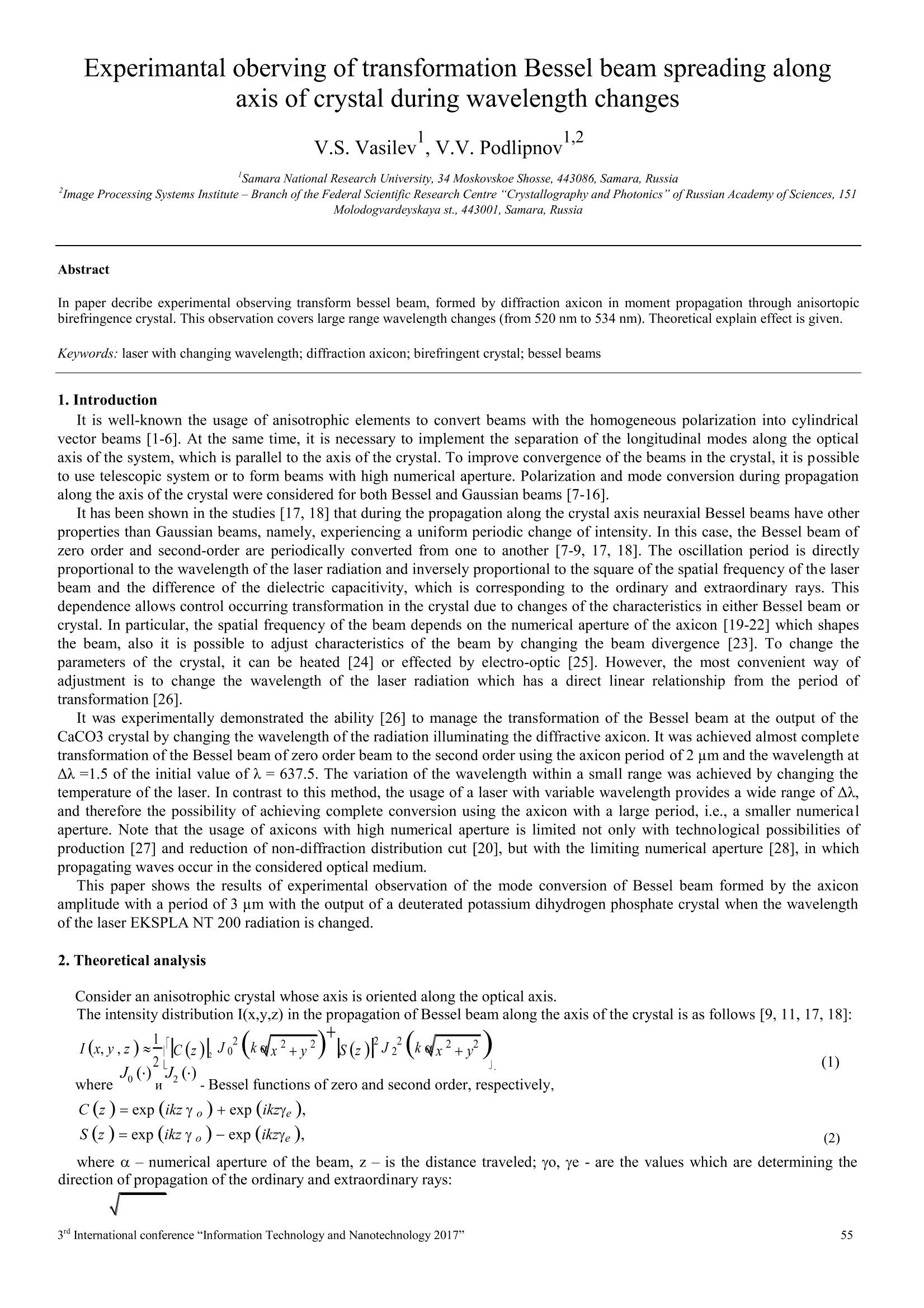
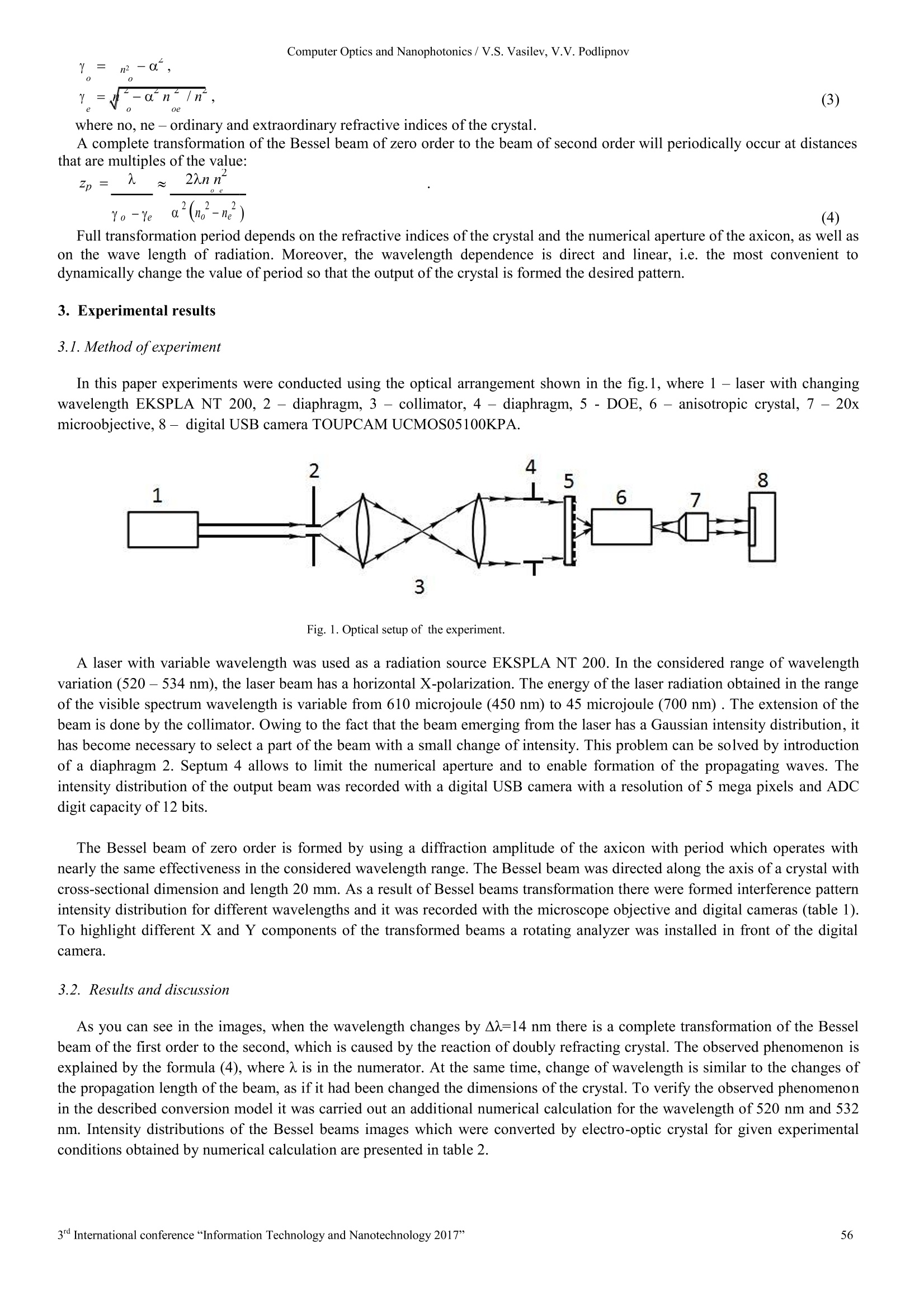

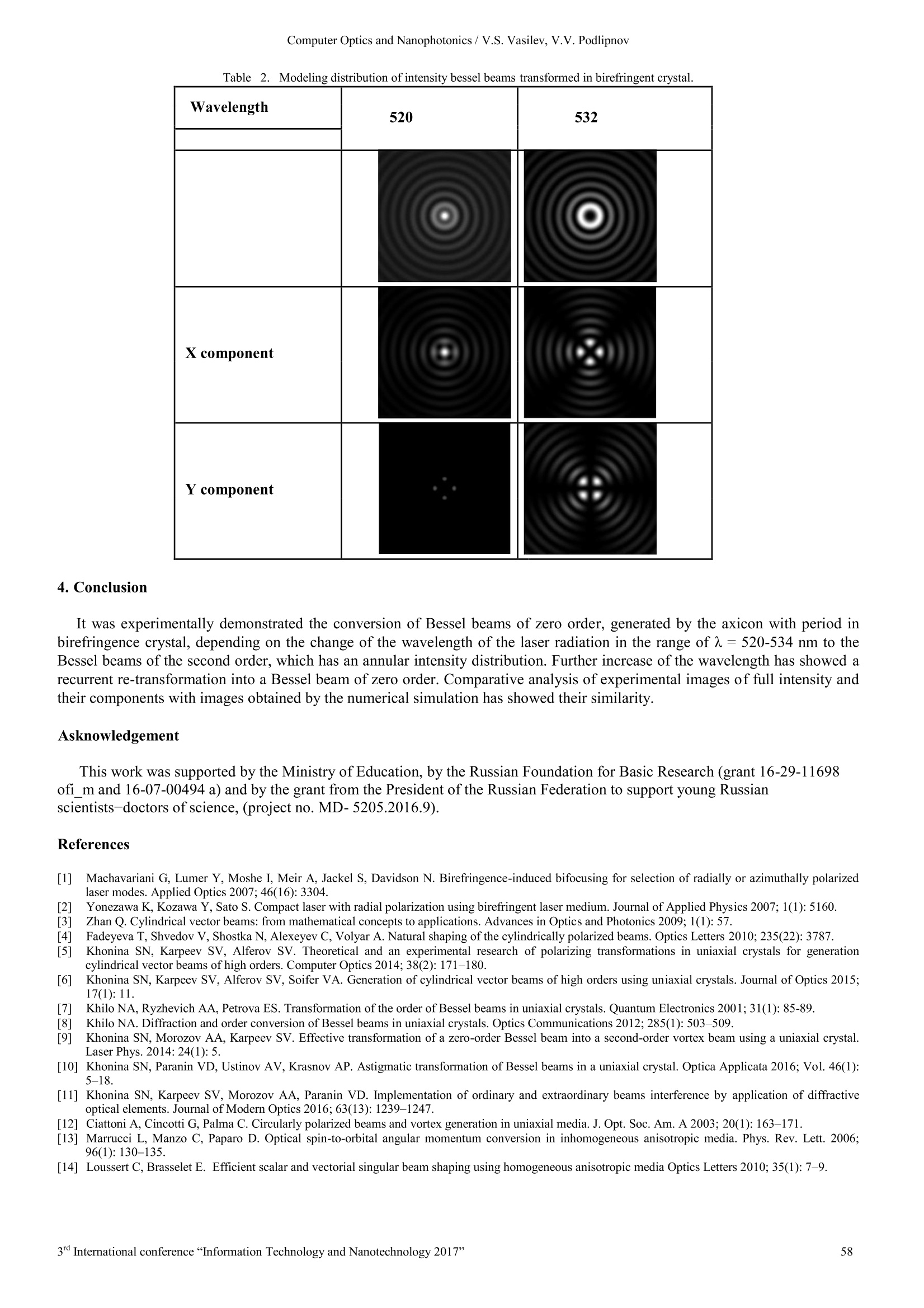
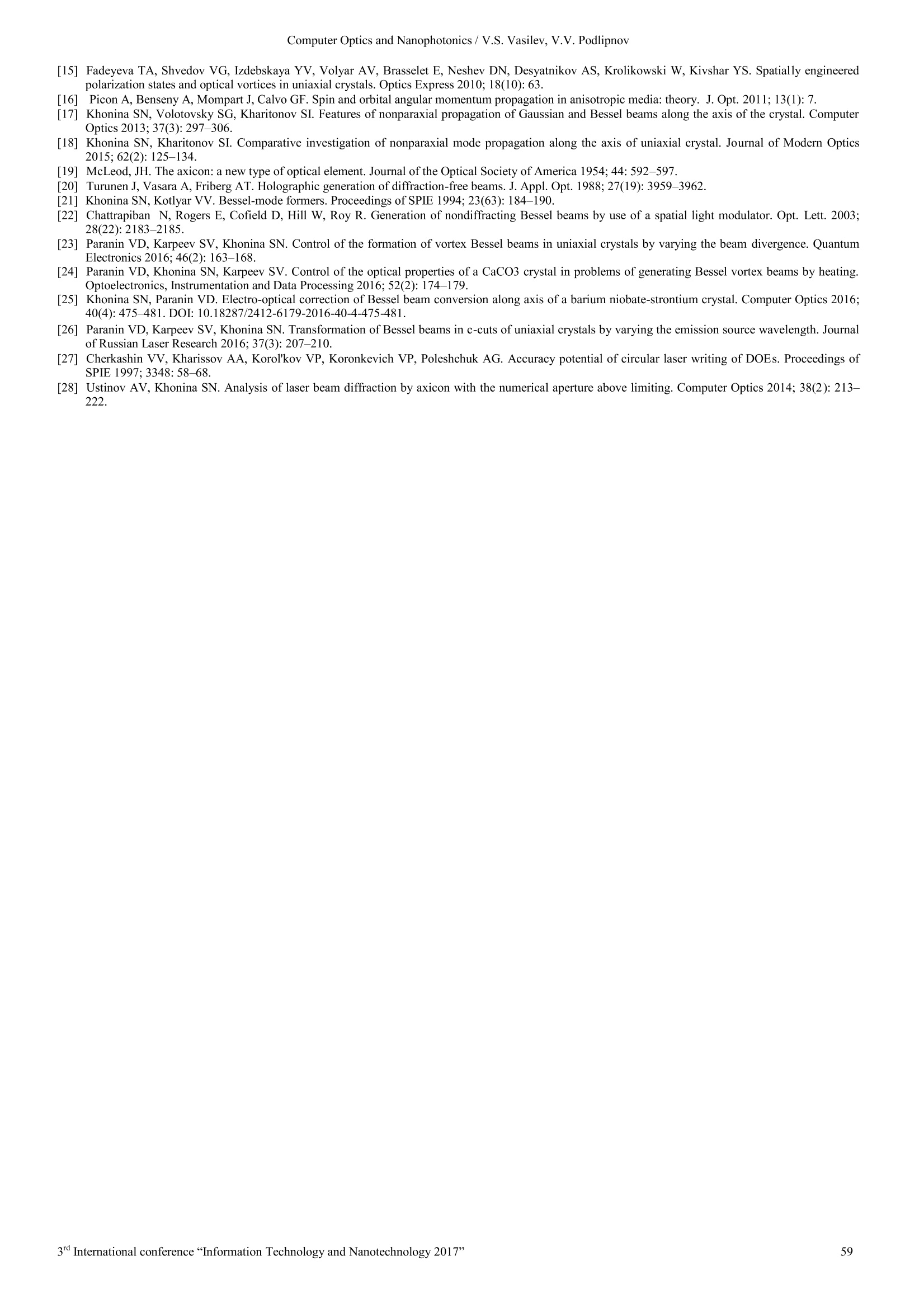
还剩3页未读,是否继续阅读?
北京欧兰科技发展有限公司为您提供《变换贝塞尔光束中沿晶体轴线扩散现象检测方案(激光产品)》,该方案主要用于其他中沿晶体轴线扩散现象检测,参考标准--,《变换贝塞尔光束中沿晶体轴线扩散现象检测方案(激光产品)》用到的仪器有Ekspla NT200 红外波段可调谐激光器
推荐专场
相关方案
更多
该厂商其他方案
更多

